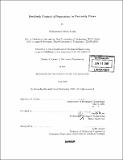Feedback control of separation in unsteady flows
Author(s)
Alam, Mohammad-Reza
DownloadFull printable version (4.310Mb)
Other Contributors
Massachusetts Institute of Technology. Dept. of Mechanical Engineering.
Advisor
George Haller.
Terms of use
Metadata
Show full item recordAbstract
Prandtl (1904) showed that in a steady flow past a bluff body, streamlines separate from the boundary where the skin friction (or wall shear) vanishes and admits a negative gradient. Despite initial suggestions, however, it was recognized that Prandtl's zero-skin-friction criterion for separation is invalid for unsteady flows. Employing a Lagrangian approach, Haller (2004) derived an exact kinematic theory for unsteady separation in two-dimensional flows. This theory predicts separation at points where a weighted average of the skin-friction vanishes. The weight function in this criterion depends on quantities measured along the wall, and hence can be used in an active feedback control of separation. Feedback control has been shown to lead to performance improvement in a range of aerodynamic applications, but no rigorous feedback law has been constructed for lack of a detailed understanding of separation. In this work, we use a wall-reduced form of the vorticity-transport equation to design a feedback controller that enforces Haller's criteria-and hence induces separation- at prescribed boundary points. We also present a stability analysis of the controller, and explore alternative control strategies for separation. We use FLUENT to validate our controller numerically on a range of flows, including steady and unsteady channel flows and backward-facing step flows.
Description
Thesis (S.M.)--Massachusetts Institute of Technology, Dept. of Mechanical Engineering, 2005. Includes bibliographical references (leaves 67-69).
Date issued
2005Department
Massachusetts Institute of Technology. Department of Mechanical EngineeringPublisher
Massachusetts Institute of Technology
Keywords
Mechanical Engineering.